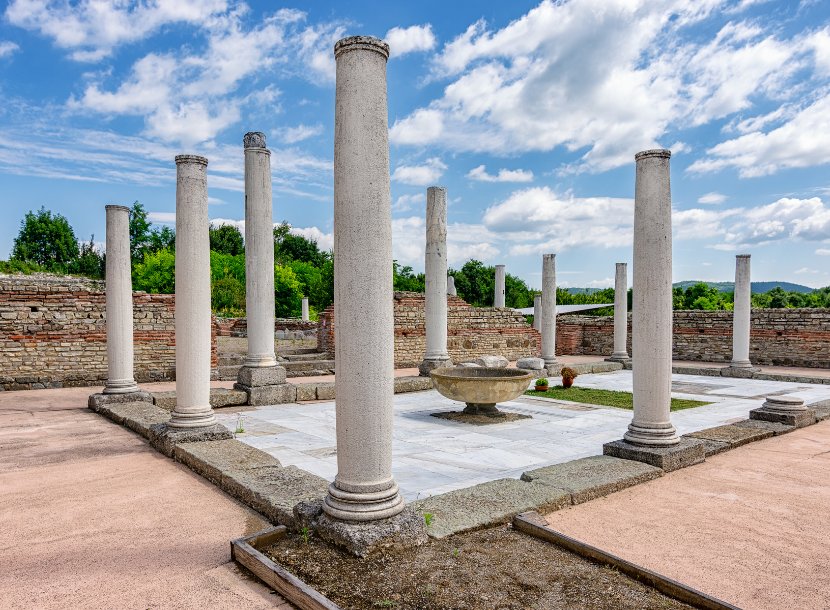Rome outside of rome
Interested in the legacy and heritage of the Ancient Roman Empire that you most likely never heard of?
- Pricing
- Duration
Starting from 2,490€ per person
10 days / 8 nights
- Pricing
From: 1,860€/person
- Duration
13 nights / 14 days
- Starting point
- End point
Belgrade
Belgrade
- Starting point
Zagreb
- End point
Belgrade
Interested in the legacy and heritage of the Ancient Roman Empire that you most likely never heard of?
If your answer is YES, then we have a few questions for you: what modern-day country had the most Roman emperors (18) born within its territory? One of these emperors includes Constantine the Great, who issued the Edict of Milan.
In which modern-day country is one of the empire’s four capitals, Sirmium, located?
If your answer to these questions was Serbia, then you are right!
Imagine exploring the land where these Roman emperors were born, legions marched, and ancient sites sit scattered across stunning landscapes!
Nearby the ancient capital sits Via Militaris, the famous ancient Roman road where Gallienus and Aurelian scored a crucial victory against the Goths at the battle of Nassius in 268 AD. Continue on this route and discover incredible ancient sites such as Viminacium, Singidunum and Gratiana. Felix Romuliana (UNESCO World Heritage Site), one of the most important late Roman locations in Europe sits close by.
The territory of today’s Serbia was once a vital frontier of the Roman Empire and is packed with remarkably preserved ancient ruins (Trajan’s Bridge to name one!), imperial palaces, amphitheaters, and military strongholds that must find their way on your itinerary!
This heritage is etched into the ruins and cities scattered across the country. It offers a fresh perspective on Roman history and is only a 45-minute flight from Rome itself, situated in the Southeastern European region of the Balkans.
Serbia also tempts with a vibrant culinary scene, where you can savor fresh, authentic, organic dishes, local wines at amazing prices while enjoying a vibrant music scene, incredible natural beauty, modern cities bustling with hospitable locals and tourists alike.
Wish to dig deeper than Rome? We can do that.
Beyond the Roman legacy you will also discover layers of captivating history from the first Proto-European civilization.
The region’s history stretches far deeper than the Roman Empire, with the archeological discovery in 1908 by Serbian archaeologist Miloje Vasic, the Vinča culture, is often called the “Cradle of European Civilization”.
Flourishing between 5,700 and 4,300 BCE, the Vinča civilization is known for the first urban settlement in Europe, pottery, incredible anthropomorphic figurines, earliest traces of smelting (hot metallurgy) and early examples of proto writing — predating Sumerians and Mesopotamia by thousands of years!
It captured the attention and support of world-famous archaeologists such as Gordon Childe, Arthur Evans, and Harald Haarmann. The Lepenski Vir Museum and the Belgrade National Museum are overflowing with artifacts from this period.
We are proud to present you with a top-notch tour of the rich ancient legacy of today’s Serbia; we do it because this unique story has been overlooked for thousands of years. TripTop Travel looks forward to hosting you on this unforgettable and truly unique journey.
Tour itinerary
Day 1: Arrival in Belgrade
Upon arrival in Belgrade, we will transfer to the hotel for check-in and some time to rest. In the evening, we will enjoy a welcome dinner at a traditional restaurant in one of the city’s most vibrant and iconic districts – the famous bohemian quarter of Skadarlija.
Overnight stay.
Day 2: Belgrade City Tour
After breakfast, we will embark on a full-day tour of Serbia’s capital. We begin with a walking tour of the city center, visiting its most notable landmarks: Kalemegdan Park, the Victor Monument, the confluence of the Sava and Danube Rivers, the Cathedral Church, Knez Mihailova Street, Terazije Square, and Republic Square.
We then visit the National Museum of Serbia, accompanied by a local guide and curator. This museum is one of the most prominent and comprehensive in the Balkans, showcasing collections from various periods of Roman imperial rule in the region, as well as prehistoric artifacts and exhibitions.
After the museum, we head to Zemun, a historic district located along the Danube, for lunch. We’ll explore the Gardoš Tower, built on the foundations of a 9th-century fortress.
Later, we visit the Church of Saint Sava, the largest Serbian Orthodox church and one of the largest in the world, offering insight into the country’s religious heritage. We continue to the Nikola Tesla Museum, dedicated to Serbia’s greatest scientist and one of the most influential inventors of all time, especially known for alternating current. Most of his patents were filed during his life in the United States, where he also passed away.
To end this rich and fascinating day, we enjoy dinner in Dorćol, a trendy neighborhood known for its modern restaurants and lively nightlife.
Return to hotel. Overnight stay.
Day 3: SREMSKA MITROVICA – SREMSKI KARLOVCI – NOVI SAD
After breakfast, we depart for Sremska Mitrovica, a city less than an hour away from Belgrade, historically known as Sirmium, the Roman imperial capital in the 3rd century AD. Founded by Emperor Galerius, Sirmium was a birthplace of many Roman emperors. During the tour, we visit the Museum of Srem, featuring Roman artifacts primarily from the 2nd to 4th century.
We then explore the remains of the Imperial Palace, a key Roman structure discovered in the 1950s. Built in the late 3rd century, this palace once included heating, irrigation, and sewage systems – a symbol of Sirmium’s grandeur.
Next, we visit Sremski Karlovci, a charming town known for its cultural and religious importance in the 19th century. Highlights include the Patriarchal Palace and the Karlovci Gymnasium.
In the late afternoon, we continue to Novi Sad, Serbia’s second-largest city and the 2022 European Capital of Culture. We will visit its key landmarks: Liberty Square, City Hall, Dunavska Street, and the Petrovaradin Fortress.
We return to Belgrade for a group dinner.
Overnight stay.
Day 4: VINČA – SMEDEREVO – VIMINACIUM
After breakfast, we travel to the Vinča archaeological site, dating back to the 5th millennium BCE. The Vinča Culture, named after this location, is recognized as one of Europe’s most advanced prehistoric societies, particularly noted for early metallurgy and planned settlements.
We continue to Smederevo, where we visit the Smederevo Fortress, built in the 15th century on the banks of the Danube, serving as the seat of the last Serbian medieval rulers before the Ottoman conquest.
Lunch break.
We then visit Viminacium, a former Roman military camp and city that existed from the 1st to 7th century AD. It was one of the largest Roman cities in the Balkans, believed to have had around 40,000 inhabitants and once served as the capital of the Roman province of Moesia Superior.
Return to Belgrade. Group dinner.
Overnight stay.
DAY 5 – LEPENSKI VIR – GOLUBAC FORTRESS – DANUBE CRUISE – KLADOVO
After breakfast, we depart toward Eastern Serbia and the town of Kladovo. Our first stop is the Golubac Fortress, a stunning medieval stronghold perched above the Danube, built upon the remains of an ancient Roman fort.
Next, we visit Lepenski Vir, one of the oldest prehistoric settlements in Europe, dating from the 10th to the 6th millennium BCE. This culture is known for its organized urban planning, artistic expression, and complex social structure.
Following lunch, we travel to Tekija and embark on a two-hour Danube River cruise, during which we will see two major Roman landmarks: the statue of King Decebalus, the last great Dacian ruler, and Trajan’s Tablet, carved into the cliffs by Roman Emperor Trajan during his 2nd-century military campaigns.
We enjoy the dramatic scenery of the Đerdap National Park (Iron Gates Gorge) before heading to Kladovo for dinner.
Overnight stay.
Day 6: NIŠ
After breakfast, we visit Fetislam, an Ottoman fortress from the 16th century, followed by two major Roman sites:
- Diana Fortress, built in the 1st century as part of the Dacian military front,
- and Trajan’s Bridge, designed by famed architect Apollodorus of Damascus in the 2nd century.
Next, we head to Rajačke Pimnice, an 18th-century rural wine village known for its authentic architecture and high-quality wines. We’ll enjoy wine tasting and lunch.
In the afternoon, we visit Felix Romuliana, a late Roman palace and imperial residence built by Emperor Galerius in the early 4th century.
After the visit, we proceed to Niš, the largest city in southern Serbia, renowned for its traditional grilled food.
Dinner and overnight stay.
Day 7: NIŠ – BELA PALANKA
After breakfast, we begin with a visit to the Skull Tower, a 19th-century monument commemorating fallen Serbian revolutionaries. We then explore Mediana, a Roman villa complex associated with Emperor Constantine the Great, who was born in Niš. This site includes remains of luxury villas and agricultural estates.
We also visit the National Museum of Niš, housing artifacts from prehistoric and Roman times. The tour concludes with a visit to the Niš Fortress, followed by lunch.
In the afternoon, we travel to Bela Palanka to explore Remesiana, a Roman town from the 2nd century that once stood on the Via Militaris, a major Roman road.
Return to Niš. Free time to explore the city independently.
Group dinner. Overnight stay.
Day 8: DAY 8 – LEBANE – PROKUPLJE – MANASIJA MONASTERY
After breakfast, we head to Caričin Grad (Justiniana Prima), a 6th-century Roman city and ecclesiastical center founded by Emperor Justinian I.
We continue to Prokuplje to visit the Toplica Museum, which contains artifacts from prehistory and Roman times, including a Gothic spear believed to date from the 5th century.
After lunch, we begin our return journey to Belgrade. On the way, we stop at the Manasija Monastery, one of the most beautiful and historically important Serbian Orthodox monasteries from the medieval period.
Arrival in Belgrade.
Group dinner. Overnight stay.
Day 9: BELGRADE
Breakfast. Free time until departure.
Transfer to the airport.
Day 10: END OF THE TRIP
Arrival home.
End of the program.
Pricing
Starting from 2,490€ per person
Included in price
- Transportation
- 4 and 5 star hotels
- All meals (breakfast, lunch, dinner)
- All entrance fees
- English speaking guides
- English speaking local archaeologists
Not included
- Single room (extra charge 800 EUR)
- Personal expenses
- Health insurance
In the Footsteps of Roman Emperors: Discover the Hidden Rome of the Balkans
Singidunum – The Roman Foundations of Modern Belgrade
On the site where the dynamic city of Belgrade now stands, the Roman city of Singidunum once flourished. Founded in the 1st century AD at the confluence of the Sava and Danube rivers, Singidunum was a key military fortress and urban settlement that protected the borders of the Roman Empire. It was the headquarters of the IV Flavian Legion, confirming its strategic importance in defending the empire’s northern frontiers.
Today’s Belgrade preserves fragments of this heritage. At the Kalemegdan Fortress, you can see remnants of Roman walls and structures. Archaeological sites beneath the modern city reveal mosaics, ceramic vessels, and coins that testify to the lives of Romans in this area.

Sirmium – The Imperial Splendor of Pannonia
Sirmium, located in today’s Sremska Mitrovica, was one of the most important cities of the Roman Empire. In March 293 AD, under the rule of Emperor Galerius, Sirmium became the empire’s capital for several decades. In the 4th century, it was noted as the most beautiful and richest city in Illyricum, and through its magnificent Imperial Palace passed about ten Roman emperors: Herennius Etruscus, Hostilian, Decius, Claudius II, Quintillus, Aurelian, Probus, Maximian, Constantius II and Gratian.
Archaeologists have uncovered remains of a Roman circus, public baths, trading quarters, and residences that showcase the rich life and culture of the Romans. Ammianus Marcellinus described Sirmium as “the mother of cities,” and today this site offers a chance to step into the world of Roman luxury and power.

Viminacium – Legionary Camp and City of Emperors
Viminacium, situated near today’s Požarevac, was a Roman military camp and city of exceptional importance for the defense of the empire along the Danube. The city held the status of a municipium and was the capital of the province of Upper Moesia. Founded in the 1st century AD, Viminacium was the headquarters of the VII Claudia Legion and an important military, economic, and cultural center.
Known for its autonomous city administration and military prowess, Viminacium offered advanced public buildings, baths, and luxurious villas. The site is open to visitors, and its rich history provides a unique insight into the daily lives of Roman soldiers and citizens as you explore reconstructed villas and walk the ancient streets of this once-thriving city.

Felix Romuliana – The Immortality of Galerius through the Architecture of Gamzigrad
Felix Romuliana, also known as Gamzigrad, is located near Zaječar in eastern Serbia. This monumental palace from the 3rd century AD was the residence of Emperor Galerius, who built it in honor of his mother Romula.
Recognized as a UNESCO World Heritage Site, it was once surrounded by strong walls with towers, housing lavish buildings adorned with mosaics, frescoes, and sculptures. The temples within the complex were dedicated to Roman gods and represented the place where Emperor Galerius spent his final days. Visiting Gamzigrad provides a unique opportunity to see how Roman architecture and art reached their pinnacle in the empire’s provinces, reflecting the power and ambition of the emperor.

Felix Romuliana, Serbia
Naissus and Mediana – The Legacy of Constantine the Great in Niš
The city of Niš, known in ancient times as Naissus, was the birthplace of Emperor Constantine the Great. His reign changed the course of history with the acceptance of Christianity and the founding of Constantinople. Just outside Niš lies Mediana, Constantine’s lavish summer residence, where he stayed when visiting his hometown.
Built in the 3rd and 4th centuries, Mediana was known for its opulent villas and as an artistic center of the empire, with many villas adorned with mosaics featuring religious scenes and mythological figures. The mosaics of Mediana are considered some of the finest in this part of Europe, and today, visitors can admire the remains of luxurious structures, making Mediana an essential stop on any journey through Roman heritage.


